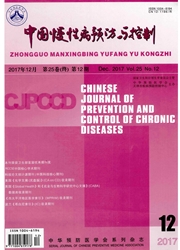

 中文摘要:
中文摘要:
目的分析高血压患者中同型半胱氨酸(Hcy)与冠心病的关系,为冠心病的防控提供依据。方法采用单纯随机法抽取在深圳市南山区居住满6个月以上及20岁以上的原发性高血压患者5 935例为研究对象,分为病例组(高血压合并冠心病患者)270例,对照组(高血压未发生冠心病患者)5 665例。通过问卷调查、体格检查和实验室检测来收集相关资料。采用χ^2检验、构建logistic回归模型计算P-trend值并分析传统危险因素与Hcy的交互作用,用再分类分析评价logistic回归模型效力。结果高血压合并冠心病患者的Hcy中位数为13.1μmol/L,而对照组为12.7μmol/L,组间差异无统计学意义(P〉0.05);高血压合并冠心病患者的高Hcy血症患病率为33.3%,而对照组为31.3%,组间差异无统计学意义(P〉0.05);未发现高血压患者中Hcy四分位数及高Hcy血症分级与冠心病存在关联,未发现Hcy与心脑血管传统危险因素在冠心病的发病中存在交互作用;在再分类分析中,再分类改进指数(NRI)为-0.012,差异无统计学意义(Z=-1.200,P〉0.05)。结论矫正传统危险因素后Hcy与冠心病的关系无统计学意义。
 英文摘要:
英文摘要:
Objective To analyze the relationship between homocysteineon (Hey) and coronary disease in hypertensive patients and to provide the evidence for preventing and controlling coronary" disease. Methods A total of 5 935 cases with hypertension ( ≥20 years old, lived in Shenzhen for over 6 months) selected by sampling method from Shenzhen Nanshan district were served as the subjects, which were divided into case group (270 hypertension patients with coronary disease ) and control group (5 665 hypertension patients without coronary disease). The investigation was conducted with questionnaire, physical examination and laboratory test. Chi-square Test and structure logistic regression model were used to obtain P-trend and to analyze the interaction between traditional risk factors and Hey, and classification analysis was used to to evaluate the validity of the logistic regression model. Results The medians of Hcy in case group and control group were 13.1 and 12.7 p, mol/L, there was no statistically significant difference between two groups (P〉0.05). The morbidities of hyperhomocysteinemia in case group and control group were 33.3% and 31.3%, respectively, there was no statistically significant difference between two groups (P〉0.05). The significant association of hyperhomoeysteinemia with coronary disease was not found. The significant interactions between homocysteine/cardiovascular disease risk factors and coronary disease was not found. The result of classification analysis showed that NRI was -0.012, there was no statistically significant difference (P〉0.05). Conclusion After adjusting the traditional risk factors, there is no significant association between Hcy and presence of coronary disease.
 同期刊论文项目
同期刊论文项目
 同项目期刊论文
同项目期刊论文
 期刊信息
期刊信息
